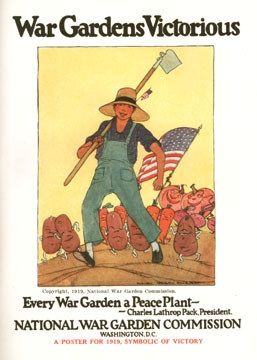Victory Gardens a Boon in Hard Times...Then and Now
I collect gardening catalogs. To me, they represent life and productivity and the promise of family, good food and good health. They also provide a link to a simpler, agrarian past that I find comforting and restorative in these unsettling times. In a world where oil gushes unabated into the Gulf of Mexico, violence seems unchecked, compassion towards the less fortunate seems to have evaporated and economic misery abounds, I find gardening catalogs a refuge of optimism. We need fewer bad things in this world and more good gardens.
I’ve spent more time this year sitting in the chair in my garden, thinking about what this small cultivated area says about these times, this world and my life. I’ve resisted buying many seeds this year; like others, the economy gives me jitters. Not that I’m without hope about the economy or the potential of gardens in this current presidential administration. Especially the latter, as the residents of the White House look favorably on sustainable and local food systems. Like our family, the first family has a garden on the front lawn. What’s more affirming than a front yard garden in hard times like these?
In hard times, Americans have always turned to gardening.
The Victory Gardens of World War I and World War II - and the garden efforts of the Great Depression - helped Americans weather hard times. These gardens helped the family budget; improved dietary practices; reduced the food mile and saved fuel; enabled America to export more food to our allies; beautified communities; empowered every citizen to contribute to a national effort; and bridged social, ethnic, class and cultural differences during times when cooperation was vital. Gardens were an expression of solidarity, patriotism, and shared sacrifice. They were everywhere...schools, homes, workplaces, and throughout public spaces all over the nation. No effort was too small. Americans did their bit. And it mattered.
Consider this: In WWI, the Federal Bureau of Education rolled out a national school garden program and funded it with War Department monies. Millions of students gardened at school, at home, and in their communities. A national Liberty Garden (later Victory Garden) program was initiated that called on all Americans to garden for the nation and the world. The success of home gardeners (and careful food preservation) helped the U.S. increase exports to our starving European Allies.
The WWII experience was equally successful. During 1943, some polls reported that 3/5ths of Americans were gardening, including Vice President Henry Wallace, who gardened with his son. That same year, according to some estimates, nearly 40% of the fresh fruits and vegetables consumed stateside were grown in school, home and community gardens. In addition to providing much-needed food, gardening helped Americans unite around a positive activity. Gardens gave all Americans a way to provide service to the nation, enabling citizens on the homefront to make significant contributions to the war effort.
Our nation again finds itself in challenging times. School, home and community gardens provide a way to respond positively to this period of uncertainty and change.
Will you do your bit?
